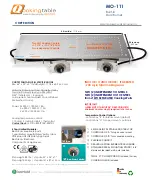
8
FURNACE FOUNDATION
• Inspect the ground conditions that you intend to
install your furnace on. If the area is unstable
or has a history of staying wet you may have to
improve the soil with gravel as well as raise the
level of furnace placement.
• A cement pad of 4-6” in thickness should be used.
• The furnace in most cases can be placed on 4
cement blocks not less than 6” wide X 10” long
and 3” thick.
• The furnace should never be installed on a
combustible floor.
• Never allow combustible material to accumulate on
the furnace foundation.
• Do not install on a combustible base
Find the footprint of the furnace you have purchased
in the appendix of this manual
and place your blocks
so the legs will stand on the center of the blocks.
Cement pads should be a little bigger than the actual
furnace, with about a 4’ extra length front and back so
you have a solid working area.
TRENCH
SteelTech Inc recommends the trench to be 24” to
36” deep and wide enough to install your water
lines. Take into consideration soil conditions as rocky
soil conditions can cause the casing of the pipe to
be damaged and allow water to fill the pipe. If soil
conditions require, fill the trench with sand.
If possible, have a gradual slope in your trench to
allow drainage away from your lines and out of
trench bottom. Most insulated underground pipe
has room for electrical wire in it. If it does not, place
electrical supply in bottom of trench and cover with
6 inches of dirt. A minimum of R8 insulation value is
recommended and a water tight vapor barrier such
as PVC pipe or drain tile to encase your insulation is a
must.
NOTE:
It is recommended that only high quality,
well insulated lines are used. Poor quality casing or
insulation can deteriorate over time causing heat loss
in the ground and loss of efficiency in your system.
Purchase your insulated line from a reputable source.
Your Heatmaster
SS
dealer will carry high quality
insulated line and can help you determine the best line
to purchase.
NOTE:
If you are installing your water lines under an
area where vehicles will cross, you should increase your
depth of the trench and use a schedule pipe over your
lines to reduce the pressure generated on the lines.
Summary of Contents for C-150
Page 2: ......
Page 23: ...heatmasterss com 23 ...









































